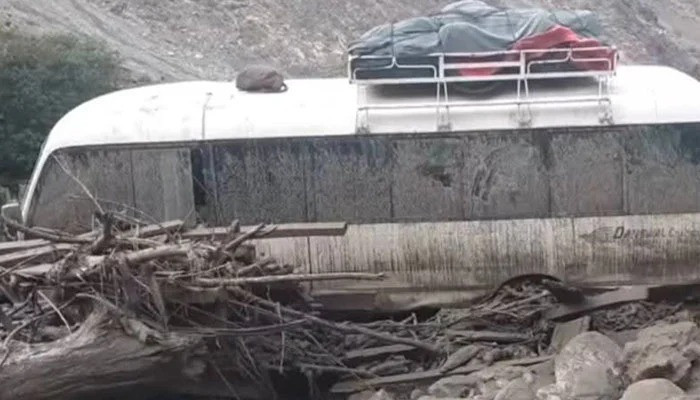All Tourists Rescued from Babusar Road; Search Continues for Missing Individuals
All 250 tourists who were marooned on Babusar Road have been successfully rescued, according to Faizullah Firaq, the spokesperson for the Gilgit Baltistan government. Efforts are now focused on locating those who are still missing.
“The Silk Road and Babusar Road remain closed for the time being. We’ve completed the rescue mission on Babusar Road, and our search is ongoing to find the missing individuals,” Firaq stated.
The spokesperson confirmed that all evacuated tourists have been moved to safety. Specifically, 250 individuals stranded on Babusar Road have been relocated to Chilas, and those who were stuck on Deosai have also been moved to a secure location.
On Monday, severe flash floods caused by torrential rains caused significant damage in the Diamer district of Gilgit-Baltistan. Tragically, at least five people lost their lives, including four tourists, and 15 others are still unaccounted for.
A sudden cloudburst at Babusar Top, a popular tourist spot in Diamer district, resulted in numerous tourists being stranded and several others sustaining injuries.
Tourists are being strongly advised to postpone any travel plans to Gilgit-Baltistan until the weather conditions stabilize. The routes to Naran and Kaghan are currently impassable, while the Silk Route is only accessible to smaller vehicles, according to the spokesperson.
Local hotel owners and the government have jointly arranged complimentary accommodations for affected travelers. However, the Karakoram Highway has been closed again at two points, leaving thousands of travelers stuck, Firaq added.
Efforts are underway to restore the Silk Road up to Bisham, the Gilgit-Baltistan government announced. Chief Minister Haji Gulbar Khan will visit the Babusar Road area affected by the floods to assess the situation.
Nationwide, at least 13 people died on Tuesday due to rains, thunderstorms, and flash floods, primarily in Khyber Pakhtunkhwa, bringing the country’s total death toll from the ongoing monsoon rains to 234.
The National Disaster Management Authority (NDMA) has issued an advisory, forecasting continued monsoon rains across most regions of the country until July 25. The advisory warns of increased risks of flooding, landslides, and glacial lake outburst floods (GLOFs) in the northern regions.
Moisture originating from the Bay of Bengal and the Arabian Sea, along with low-pressure systems developing in nearby areas, is expected to bring moderate to heavy rainfall across the country in the coming days.
The NDMA highlighted a significant threat of landslides and GLOFs in mountainous areas, particularly in Gilgit-Baltistan and upper Khyber Pakhtunkhwa. There is also a potential for rising water levels in the Indus, Jhelum, Chenab, and Kabul rivers.
Low to moderate flooding is anticipated on the Chenab River at Marala, Khanki, and Qadirabad. Increased water flow is also expected in the upper catchment of Mangla on the Jhelum River and at Nowshera on the Kabul River. Water levels are likely to increase at Tarbela, Kalabagh, Chashma, Taunsa, and Guddu barrages.
In Khyber Pakhtunkhwa, the Swat and Panjkora rivers and their adjacent streams face the risk of flooding. In Gilgit-Baltistan, a flood-like situation could develop in the Hunza and Shigar rivers, with flash floods expected in the streams of Khunjerab, Shimshal, and Saltoro.
Similarly, in Balochistan, streams in Musakhel, Sherani, Zhob, and Sibi districts are vulnerable to flooding due to the anticipated heavy rainfall.
The NDMA cautioned that landslides remain a major concern in northern areas because of continuous rain. The Karakoram Highway and Babusar Top remain closed to traffic due to multiple landslides.
Travelers are strongly urged to avoid travelling to mountainous areas until July 25. The public is also advised to avoid crossing streams, bridges, and waterlogged roads to ensure safety.
Local administrations have been directed to keep essential machinery and dewatering pumps ready for swift drainage and emergency response.
Moderate to heavy rainfall is anticipated in upper and northeastern Punjab, including Islamabad, Rawalpindi, Murree, Galliyat, Attock, Chakwal, Jhelum, Mianwali, Hafizabad, Sargodha, Faisalabad, Sialkot, Narowal, Okara, Lahore, Gujranwala, Gujrat, Multan, Bahawalpur, Bahawalnagar, Rahim Yar Khan, Dera Ghazi Khan and nearby areas from July 21 to 24, with intermittent breaks.
In Balochistan, isolated rainfall is expected in Ziarat, Kalat, Musakhel, Khuzdar, Awaran, Barkhan, Sibi, Jaffarabad, Dera Bugti and nearby districts from July 20 to 24.
Low to moderate rainfall is also expected in Sindh, covering Sukkur, Larkana, Jacobabad, Khairpur, Karachi, Hyderabad, Tharparkar, Thatta, Badin, Mirpur Khas and adjacent regions from July 19 to 24.
In Khyber Pakhtunkhwa, moderate to heavy rainfall is predicted from July 19 to 24 in areas including Chitral, Dir, Haripur, Karak, Kohat, Kohistan, Khyber, Kurram, Mansehra, Mohmand, Nowshera, Malakand, Charsadda, Abbottabad, Bannu, Buner, Hazara, Peshawar, Swabi, Swat, and Waziristan.
In Gilgit-Baltistan and Azad Jammu and Kashmir, isolated rainfall is expected in Astore, Skardu, Hunza, Shigar, Bagh, Neelum Valley, Muzaffarabad, and surrounding areas from July 19 to 24.



Comments (0)
No comments yet. Be the first to comment!
Leave a Comment